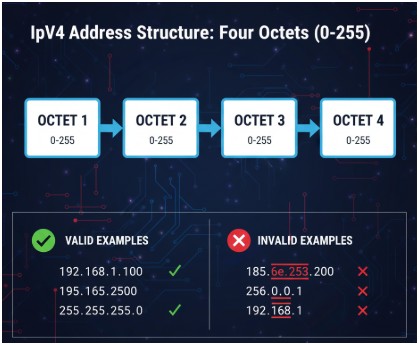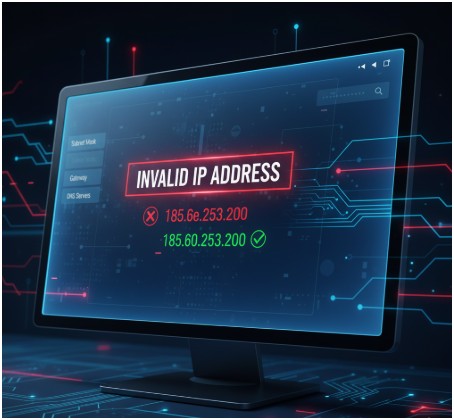I’ll be honest — the first time I came across 185.6e.253.200, I thought my eyes were playing tricks on me. I was troubleshooting a network issue for a friend, and this strange string popped up in the logs.
At first glance, it looked like an IPv4 address. But the “e” threw me off completely. Turns out, it wasn’t my eyes — it was the address itself that was wrong.
If you’ve stumbled on 185.6e.253.200 too, you’re probably wondering what’s going on. Let me walk you through why this address is invalid, how IPv4 really works, and what you should do when you see something like this.
What Is an IPv4 Address Supposed to Look Like?

To understand why 185.6e.253.200 doesn’t work, you need to know the basics of IPv4. Every device connected to the internet or a network needs a unique identifier — that’s what an IP (Internet Protocol) address is. In IPv4, this address is made up of four numbers, called octets, separated by periods.
Each octet:
- Must be a number between 0 and 255.
- Can’t contain letters, spaces, or special characters.
- Has to follow the format xxx.xxx.xxx.xxx.
For example, valid IPv4 addresses look like:
- 192.168.0.1
- 8.8.8.8
- 185.6.253.200
See how clean and numeric those are? That’s exactly what makes them valid.
Why Is 185.6e.253.200 Invalid?

When I examined 185.6e.253.200 more closely, two glaring issues popped out immediately:
1. That Sneaky “e” Breaks the Rules
IPv4 addresses can only contain numbers. The second octet here is 6e, which includes a letter. That alone disqualifies it from being a valid IPv4 address. There’s no wiggle room — letters simply don’t belong in IPv4 formatting.
2. Scientific Notation Isn’t Allowed
Some people assume the e is shorthand for scientific notation — like 6e1 meaning 60. While that’s valid in math, it’s not valid in IP addressing. Even if you interpret 6e as 60, the format is still wrong. IP parsers expect plain decimal numbers, not scientific notation.
In short, the presence of e makes the entire address unusable.
What Happens If You Try to Use 185.6e.253.200?
I learned this the hard way: your device or software will reject 185.6e.253.200 instantly. Most systems will throw a “bad address” or “invalid input” error. Network tools like ping, traceroute, or even browser address bars simply won’t recognize it.
Even worse, if this malformed address is part of a larger configuration — like a DNS record or firewall rule — it could break your network setup or stop devices from communicating properly. That’s why spotting and fixing it right away is so important.
How to Fix 185.6e.253.200 (and Avoid Similar Mistakes)
If you or someone else typed 185.6e.253.200 manually, the fix might be as simple as a typo correction. The likely intended address is 185.6.253.200 — which is valid. Double-check any documentation, logs, or config files to confirm.
Here’s what I do whenever I run into a questionable IP:
- Check for typos. A single misplaced character can break everything.
- Validate with a tool. Use online IP validators or simple scripts to test if an address is in the correct format.
- Watch for copy-paste errors. Sometimes hidden characters sneak in when copying from PDFs or emails.
- Automate if possible. Scripts or software that format IPs correctly can prevent these errors from happening again.
Catching small mistakes like this early saves a ton of troubleshooting time later.
Common IPv4 Mistakes Like 185.6e.253.200
It’s not just about rogue letters — here are other mistakes I’ve seen (and made myself):
- Numbers over 255: Something like 192.300.1.1 is invalid because 300 is too high.
- Missing octets: 192.168.1 (only three parts) doesn’t work.
- Extra periods: 192.168..1.1 is invalid because of the double dot.
- Spaces or hidden characters: 192. 168.1.1 might look fine but won’t parse.
185.6e.253.200 falls into the same category: it breaks the simple, strict format IPv4 relies on.
FAQs About 185.6e.253.200
Is 185.6e.253.200 ever valid in any context?
No, it isn’t valid anywhere in IPv4 networking. Because it contains a letter (e), it doesn’t meet the numeric-only rule required for each octet. Even if you interpret 6e as 60, scientific notation isn’t supported in IP addresses.
Could 185.6e.253.200 be a typo for a real IP?
Very likely, yes. The most probable intended address is 185.6.253.200. If you’re debugging a network issue or following a tutorial and see 185.6e.253.200, try replacing it with that corrected version and test again.
What tools can I use to check if an IP is valid?
There are plenty of free online IP validators where you can paste an address to see if it’s valid. Command-line tools or scripts written in Python, Bash, or PowerShell can also validate format before applying addresses in real setups.
Can invalid IPs like 185.6e.253.200 pose a security risk?
On their own, no — they simply won’t work. But if they appear in critical configurations (like firewall rules), they can lead to misconfigurations that accidentally open your system to risks. That’s why it’s important to fix them immediately.
Final Thoughts: Small Details Like 185.6e.253.200 Can Break Big Things
The day I ran into 185.6e.253.200 was a great reminder that even a tiny mistake can bring everything to a halt. Networking is unforgiving when it comes to syntax — one stray character can turn a valid configuration into a frustrating mystery.
If you ever see something like 185.6e.253.200, don’t panic. Check for typos, correct the format, and remember the golden rule: four octets, numbers only, each between 0 and 255. Stick to that, and your network will thank you.

